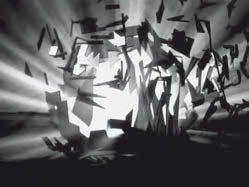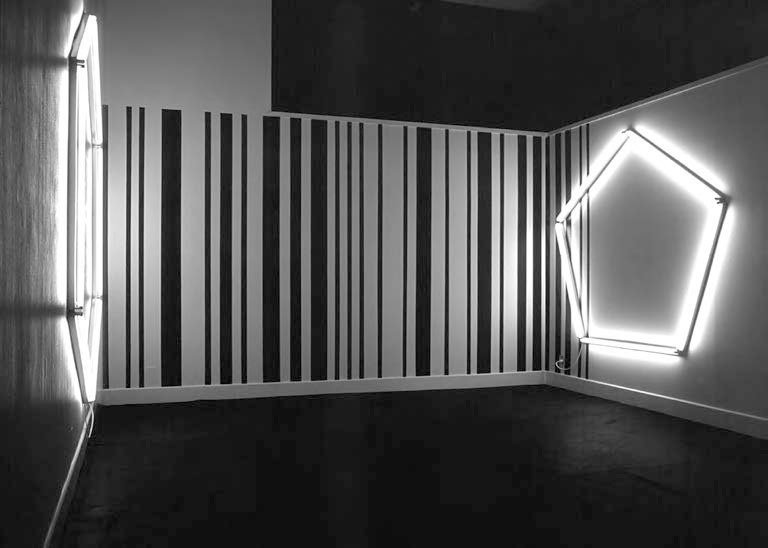tuning70
__
2002
Installation
Govett-Brewster Art Gallery,
New Plymouth
Leuchtstoffröhren (100 cm)
Wandfarbe
Traummaschine
Film
DV auf DVD-PAL/4:3
1 min (Loop)
Regie: Maix Mayer
Grafik: Bernd Fraedrich
Sound: Simone Danaylowa
2002
Installation
Govett-Brewster Art Gallery,
New Plymouth
Fluorescent tubes (length 39.4 in.)
Decorator’s paint
Dreamachine
Film
DV on DVD-PAL/4:3
1 min (loop)
Directed by: Maix Mayer
Graphics: Bernd Fraedrich
Sound: Simone Danaylowa



Filmstills
Movie still
Die geometrischen Grundformen (Fünf- und Sechs-ecke) des Kugelhauses können mit Leuchtstoffröhren als Wandgestaltung zusammengesetzt werden. Dabei sind verschiedene Kombinationen der Wandfarben in der Art eines Barcodes (z. B. für den Titel einer internationalen Architekturzeitschrift) und der Leuchtintensität der Lampen nach individuellen Vorlieben möglich. Die Filmprojektion zeigt eine Version des animierten Kugelhauses, das wie die moderne Architektur in Michelangelo Antonionis Roadmovie Zabriskie Point (1970) explodiert.
Die utopisch-hoffnungsvolle Aussage der Animation aus melancholie70 (vgl. S. 102) wird in tuning70 relativiert. Beispielhaft steht dafür ein weltumspannendes Ereignis aus dem Jahr 1970, das den Glauben an einen unbegrenzten Fortschritt erschütterte: Im April geriet die NASA-Mondmission Apollo 13 nach der Explosion eines Sauerstofftanks an den Rand einer Katastrophe. Über Tage hielt die Welt den Atem an, nachdem die Crew an das Kontrollzentrum gemeldet hatte: „Houston, wir haben ein Problem.“
Traummaschine
In den 1960er-Jahren konstruierten der amerikanische Schriftsteller und Künstler Brion Gysin (1916–1986) und der Mathematiker Ian Sommerville (1940–1976) eine Art Lichtorgel, die man als „dreamachine“ („Traummaschine“) bezeichnete. Dafür wurde ein Zylinder mit ausgeschnitten Flächen auf einem Plattenspieler installiert. Im Inneren des Zylinders befand sich eine 100 Watt-Lampe. Bei 78 Umdrehungen pro Minute besaß das durch die Löcher austretende Licht eine Frequenz von 8 bis 13 Impulsen pro Sekunde, was den den sog. „Alpha-Wellen“ im menschlichen Gehirn entspricht und bei längerer Betrachtung psychoaktiv wirkt.
Für die Arbeit Traummaschine wurde dieser Bauplan mit den beiden Grundformen des Kugelhauses ausgeführt.
The basic geometric shapes (pentagons and hexagons) of the Kugelhaus can be put together using fluorescent tubes to make a wall installation. Various combinations of wall paint in the style of a bar code (e.g. for the title of an international architecture magazine) and the wattage of the lamps are all possible according to individual taste. The film projection shows a version of the animated Kugelhaus, which explodes like the modern architecture in Michelangelo Antonioni’s film Zabriskie Point (1970).
In contrast to the hopeful, utopian statement in the animation in melancholie70, tuning70 stands for the relativization of utopian designs.
An example of that is the event of 1970 that shook the world’s faith in unlimited progress. In April of that year, the NASA moon mission Apollo 13 came to the brink of disaster following the explosion of an oxygen tank. The world was on edge for several days after the crew radioed to mission control: “Houston, we have a problem.”
Traummaschine
(dreamachine)
In the 1960s, Brion Gysin and Ian Sommerville constructed a kind of light organ which was called the dreamachine. A cylinder with cut-out surfaces was mounted on a record player. A hundred-watt globe was installed inside the cylinder. At 78 revolutions per minute, the light streaming out through the holes had a frequency of 8 to 13 pulses per second. That is the equivalent of the alpha waves in the human brain, and has a psychoactive effect if watched for a long time. The work traummaschine employed the dreamachine building plans with both the basic forms of the Kugelhaus.


Installationsansicht
Installation view

